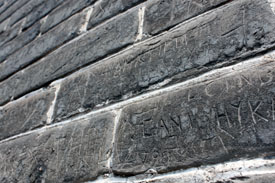
How can you combat this unsightly rippling in your thighs, derriere and even arms? Update your arsenal with the hottest treatments and products that fight your cellulite.
By Ivette Figueroa
The hard facts: Eighty percent of U.S. women have cellulite—young, old, fat, thin, it doesn’t matter. The sad truth is that being a woman is all it takes, since the underlying causes are hormones, fat and heredity. And while we all recognize our dimpled derrieres to be the outcome of dear-old-mom’s gene pool, the problem is a lot deeper than that.
“Cellulite is a description of the type of subcutaneous fat women have that is genetically and hormonally controlled. [But the key] is the difference in the anatomy of fat between men and women,” says Dr. Laura Skellchock, a board-certified cosmetic dermatologist in Boca Raton, FL. In other words, we’re just built differently.
Cellulite 101
 So what exactly is cellulite? Cellulite is that pockmarked appearance of the skin that occurs when fat cells get trapped in the connective tissue just below the skin. According to Dr. Fadi Bejjani, when your cellulite begins to show, it’s because your fat cells are full of extra water and toxins that cause swelling and inflammation. “This chronic inflammation of the fat in women, and sometimes in men, is subject to different hormonal and genetic factors. The fat gets lumpy and fibrotic,” says Dr. Bejjani, a cosmetic surgeon at the Advanced Minimally Invasive Surgery center in Morris Plains, NJ.
So what exactly is cellulite? Cellulite is that pockmarked appearance of the skin that occurs when fat cells get trapped in the connective tissue just below the skin. According to Dr. Fadi Bejjani, when your cellulite begins to show, it’s because your fat cells are full of extra water and toxins that cause swelling and inflammation. “This chronic inflammation of the fat in women, and sometimes in men, is subject to different hormonal and genetic factors. The fat gets lumpy and fibrotic,” says Dr. Bejjani, a cosmetic surgeon at the Advanced Minimally Invasive Surgery center in Morris Plains, NJ.
But the actual appearance of that cottage cheese skin is usually restricted to women. “It’s anatomic, basically. Men and women have differences in the fibrous bands that separate the fat,” says Dr. Skellchock. In most men, this connective tissue is arranged in a crosshatched pattern. But for women, the connective tissue runs vertically, tethering the skin to the tissue below it. Because of this, says Dr. Skellchock, pockets called “fat chambers” are created which push up on the skin while the fibrous bands pull the skin down—hence the orange peel effect. This difference, plus the fact that men usually have thicker skin than women, explains why few men have cellulite.
“It’s also dependent on estrogen,” says Dr. Skellchock. Many postnatal women or women on birth control develop cellulite because the body’s waste system can’t get rid of the enormous flow of estrogen. The flip side of that is a lack of male hormones, which makes treating cellulite more difficult, says Dr. Jean Paul Osores, an anti-aging and aesthetic medicine expert in Lima, Peru. “It’s very important that women are in equilibrium for male hormones. If she doesn’t have enough male hormones, she’ll never get rid of cellulite,” he says. “If you look at female body builders, they have no cellulite. This is for two reasons: They are in great physical health and they have more male genetic characteristics, which means more male hormones.”
Lifestyle choices have an effect as well. Besides having a poor diet, living a sedentary lifestyle can lead to weight gain, bad circulation and fluid retention—all risk factors for developing cellulite. “Inactivity, stationary-type jobs, contraceptives, stress [which affects the way fat is metabolized]—there is no one reason, it is a combination of things,” says Dr. Bejjani.
The role of stress in the development of cellulite doesn’t stop there. “Stress affects the release of cortisol and catecholamines and those are also trigger factors,” says Dr. Skellchock. “Cortisol actually makes you fat, especially around the central section [back and abdomen].”
Aging plays a part, too, as loss of volume and thinning skin allow cellulite to become more evident over time.
Can Cellulite Be Prevented?
While you don’t have control over your genes or gender, there are ways to prevent cellulite. Eating healthy, low-fat foods such as fruits and vegetables is a start. But the anti-cellulite diet is more about what not to eat. Caffeine, salty and fatty foods create excess water in the body, which cause the fat cells to swell.
Exercising regularly, maintaining a healthy weight and reducing stress are also recommended. So preventing cellulite is about creating a lifestyle that helps manage fat in the body—which means building fat-burning muscle and increasing your blood flow through cardiovascular exercise. “I want to emphasize that diet and exercise are definitely key,” says Dr. Bejjani. “Prevention is important and getting a consultation early on is vital.”
Can Cellulite Be Treated?
In the battle against cellulite, there’s also an arsenal of after-the-fact remedies ranging from Mesotherapy—fat-busting injections of plant extracts and other herbal substances—to various combinations of mechanical massage, radiofrequency, laser light energy and vacuum suction. While some women prefer letting the skin-kneading rollers of mechanical massage devices do their stuff, others prefer heat-generating laser or radio frequency treatments for the promise of longer-lasting results.
“If you are talking about connective tissue sagging,” says Dr. Inna Belenky of Viora, “when you apply heat to the dermis, it produces collagen remodeling, which means that it destroys old collagen and the heat stimulates new collagen growth.” Mechanical rollers or vacuum massage, meanwhile, improve poor blood circulation.
And let’s not forget the cellulite-busting properties of firming creams. Packed with antioxidants, retinol and caffeine ingredients, these anti-cellulite moisturizers promise to diminish that dimpled appearance by tightening the skin, reducing fat and retexturing the skin. Unfortunately, creams alone are not always enough to tackle the problem, especially for the more advanced cases. In the end, devices and treatments are most often your best bet.
While no U.S.-approved studies on Mesotherapy have been conducted, European-published studies suggest that a number of its herbal ingredients may theoretically reduce fat and are effective in removing small collections of adipose tissue. Dr. Osores has used mesotherapy with some success, although he advocates a combined approach of liposuction, ultrasound and massage.
Dr. Bejjani’s preferred method is VelaShape, a non-invasive treatment that uses heat and mechanical massage to smooth out cellulite. “The advantage is that you can do large surfaces. I’ve had the best success with stage 1 and 2 [mild to moderate] cellulite,” he says.
“Cellulite is a twofold problem—we have enlarged fat cells and toxins trapped in the fat cells,” says Dr. Donna Freeman of Chromogenex, whose i-Lipo device reduces the size of fat cells “and then uses the vacuum massage to release the connective fiber and encourage tissue stimulation.”
The future of the war on cellulite looks even more promising with new laser contenders, such as Cynosure’s Cellulaze, entering the fray. Now with FDA approval, Cellulaze has undergone clinical trials with encouraging results. One long-term study showed that even after the one-year mark, patients on average maintained an improvement of 3.4 (on a 0 to 5 ascending scale) for cellulite reduction and a 3.9 on textural improvement after one treatment.
Here’s hoping for that magic bullet that works for you.
Cellulite Treatments
Tackling the orange-peel effect beneath the surface
 The Treatment: VelaShape (Syneron-Candela), $250 per session, per body part
The Treatment: VelaShape (Syneron-Candela), $250 per session, per body part
How It Works: Vacuum and mechanical massage rollers smooth out the skin to facilitate efficient heat delivery from the radiofrequency and infrared light energy. The result is an increase in lymphatic drainage and a reduction in the size of the actual fat cells.
The Skinny: Like a warm deep-tissue massage. Expect redness and a warm sensation post-treatment. Each session is 45 minutes and most need 4 to 6 for lasting results.
 The Treatment: I-Lipo Ultra Plus (Chromogenex), $300 to $700 per session
The Treatment: I-Lipo Ultra Plus (Chromogenex), $300 to $700 per session
How It Works: FDA-approved, uses low-level laser light to ‘bio-stimulate’ fat so that stored triglycerides are broken down and released as free fatty acids and glycerol that can then be used by the body as a ready energy source. Uses vacuum massage to enhance.
The Skinny: Studies have show that after eight treatments (recommended over two months) there is an 8 to 10 percent reduction in body-part circumference.
 The Treatment: Cellulaze (Cynosure), $5,000 to $7,000 for one session
The Treatment: Cellulaze (Cynosure), $5,000 to $7,000 for one session
How It Works: A laser fiber inside of a cannula delivers energy directly under the skin, improving thickness and quality, while simultaneously releasing the fibrous bands that pull skin down. The procedure takes about one to two hours, with full results in three to twelve months.
The Skinny: Because the area is numbed with local anesthesia, there is minimal discomfort. Following treatment, there may be some soreness and bruising. Small amounts of fluid may leak from the incision sites and you may need to wear a compression garment.
 The Treatment: Reaction RF (Viora), $150 – $400 per session, per body part
The Treatment: Reaction RF (Viora), $150 – $400 per session, per body part
How It Works: Uses both vacuum massage and radiofrequency (RF). The massage improves blood circulation and lymphatic drainage; heat produced by the RF destroys old collagen and stimulates new collagen growth for better skin thickness and texture.
The Skinny: Uses three different radiofrequencies together so that it can reach three different layers of the skin; needs 6-to-8 20-minute treatments for maximum effect.
 The Treatment: Mesotherapy, $350 – $600 per session, per body part
The Treatment: Mesotherapy, $350 – $600 per session, per body part
How It Works: A small amount of medication, vitamins, supplements and plant extracts are injected into the fat and connective tissue of the dimpled areas. The solution is said to break down fat and block the production of new fat cells.
The Skinny: You’ll need 4 to 10 treatments depending on the size of the area being treated. Some bruising is possible, but the injections are virtually painless.
 The Treatment: Endermologie (LPG), $50 to $100 per session
The Treatment: Endermologie (LPG), $50 to $100 per session
How It Works: A mechanical massage with large rollers stimulates and softens the tissue, breaking up the compartmentalized fat and reducing the appearance of cellulite.
The Skinny: The sensation of the rolling machines is similar to deep-tissue massage. Temporary bruising may occur. You will need 10 to 14 sessions to see significant results.
Topical Treats
By: Zoe Schaeffer
Tackling the orange-peel effect beneath the surface
 Scrub It Out
Scrub It Out
Scrubbing smoothes out surface irregularities and stimulates blood flow, and this botanical-based exfoliator does the trick. Enriched with green coffee to help break down fat, plus chili and ginger to boost circulation, The Organic Pharmacy Resculpting Scrub is the latest offering from this British brand’s Firm and Slim line. $75, available at theorganicpharmacy.com.
 Smooth Moves
Smooth Moves
Christian Dior’s Svelte Reversal fights cellulite with an exclusive Reversal Complex that attacks pre-disposed cells before they turn into dimpled skin. By reducing excess fat tissue, it creates a “stocking effect,” where skin is instantly smoothed and imperfections disappear. Christian Dior Svelte Reversal; $62, available at Macy’s.
 Firm Foundation
Firm Foundation
Developed with a new micro-lattice technology to provide a tightening feeling in the skin, Elemis Pro-Collagen Body Cream instantly creates smoothness. Acacia, an anti-aging peptide, plus a marine extract, firm the butt, stomach and arms. Elemis Pro-Collagen Body Cream; $90, available at elemis.com.
 Oil Spill
Oil Spill
Research shows that the essential oils in this body-contouring product smooth and tone skin. Nuxe recommends using a massage technique called papier-rouler: Pinch a fold of skin and roll it between fingers from the bottom up; it can help drain fluid from fat cells to improve overall texture. Nuxe Body Contouring Oil; $37, available at beauty.com.
 Gelling It
Gelling It
Caffeine-based topical creams are among the best options for cellulite (and fat) reduction. Stellar Cellulite Gel is a physician’s strength, caffeine-enriched formula with a triple action Bio-Marine complex that includes sea kelp to detoxify and crushed pearl to exfoliate. Contains 21 key ingredients in a shimmery Bio-Marine gel. $53, available at stellarinskin.com.
 Fat Attack
Fat Attack
Scientific studies have revealed the role of the protein Sirtuin in cell longevity; it helps tap the fat stored in fat cells and activates the breakdown of lipids. Orlane Lipo-Reducing Slimming Gel also uses lotus leaf and caffeine to achieve a complete slimming effect. $150, available at Neiman Marcus.
Reposted courtesy of New You Magazine.
Popularity: 50%
You Should Also Check Out This Post:
- Outdoor Living in South Florida
- Making it the Green Way
- Dreammakers for Life
- Gone to College
- Broward Landscape














 Ivette currently works as an associate editor for Lifestyle Media Group, a Florida-based company that publishes regional lifestyle magazines. Previously, she was a copywriter for DentalPlans.com, the leading online distributor of discount dental plans. She was also the associate editor for New You Magazine, a national publication that covers the topics of cosmetic surgery, anti-aging medicine and beauty products.
Ivette currently works as an associate editor for Lifestyle Media Group, a Florida-based company that publishes regional lifestyle magazines. Previously, she was a copywriter for DentalPlans.com, the leading online distributor of discount dental plans. She was also the associate editor for New You Magazine, a national publication that covers the topics of cosmetic surgery, anti-aging medicine and beauty products.